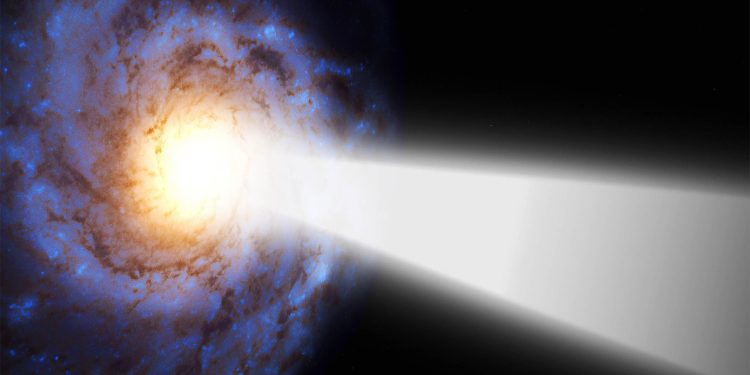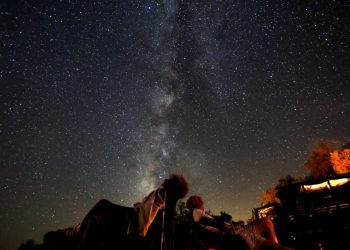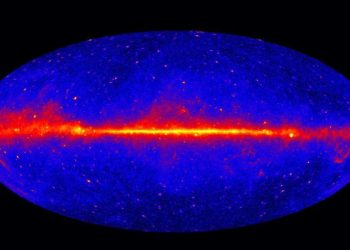Astronomers report longest gamma-ray burst ever recorded, confirmed in new paper. The signal, labeled GRB 250702B, flashed for about 7 hours after NASA’s Fermi telescope first saw it on July 2, 2025.
The team says the engine was not a normal collapsing star. They present evidence that a pre-existing black hole dove into a partner star and blasted jets from deep within.
GRB 250702B is unprecedented
Simply put, a gamma-ray burst (GRB) is the most energetic explosion in the universe. They can briefly eclipse entire galaxies and are often followed by afterglows in X-ray, optical, and radio wavelengths.
GRBs typically occur when a star collapses into a black hole, releasing a sudden burst of extremely energetic light that lasts only a few seconds. A rare class called ultra-long events lasts more than 1,000 seconds.
This particular gamma-ray burst, GRB 250702B, continued for 25,000 seconds, obliterating the previous record holder – GRB 111209A, which was linked to a bright supernova.
“In observational terms, it just doesn’t look like any of the other things in this category that we’ve seen,” said astrophysicist Daniel Perley of Liverpool John Moores University. Science.
A helium merger is a compact black hole falling into a bare star and feeding for hours.
As the black hole spins inward, it builds an accretion disk, a hot, magnetized ring of incoming gas that can launch jets.
One likely energy source is the Blandford Znajek mechanism, which exploits the black hole’s rotation through magnetic fields to drive these jets.
Main signs of a gamma-ray burst
The light curve shows rapid flickers of about a second. This short time frame suggests a compact engine, compatible with a stellar mass black hole rather than a supermassive black hole.
The team detected photons in GRB 250702B’s multi-MeV range, implying that its jets were traveling at extreme speeds. They deduce a high Lorentz factor, a number that describes how close the jet’s speed is to the speed of light.
The burst spectrum also lacks a significant delay between hard and soft photons. This pattern corresponds to many long bursts powered by narrow, ultra-fast jets.
Telescopes confirm GRB 250702B
Follow-up spectroscopy with the Webb telescope measured a redshift of 1.036. The same study found no obvious supernovas at the burst site approximately 25.5 days after the event in the source’s quiescent setting.
A measured redshift, a shift in spectral lines caused by cosmic expansion, allows scientists to estimate distance and energy. It also allows comparisons to be made with previous ultra-long bursts.
The position is far from the center of the host galaxy, arguing against a supermassive black hole tearing apart a star.
This scenario, a tidal disruption event (TDE), a star torn apart by a giant black hole, is expected to occur at the heart of a galaxy.
Known reasons for long GRBs
Typical GRBs occur when a massive star collapses in on itself, a collapse, becoming a black hole. The rotation and structure of a star generally limits the burst to one or two minutes at most.
A merger, on the other hand, involves two compact objects – usually neutron stars or a neutron star and a black hole – spiraling into each other and colliding after millions or billions of years.
This collision releases a huge burst of gamma rays, but it is much shorter, usually lasting less than two seconds.
A long, low power rate can still keep the jets lit if the black hole spins fast enough. This would explain the long duration of the GRB 250702B, with a power level similar to ordinary long bursts.
No bright supernovas appeared in the Webb telescope’s follow-up study, a finding consistent with the disk’s weak winds and the lower amount of radioactive nickel created in the disk.
The study authors suggest that any explosion could have been small, muffled by dust, or both. Either way, a dark event would be a better fit for a merge channel than a manual collapse.
Further studies are needed on GRB 250702B
If helium mergers generate ultra-long bursts, they should favor star-forming regions rich in massive binaries. They may prefer heavier, dustier galaxies than typical long-burst hosts.
Finding them is difficult because they move slowly and often with lower maximum brightness. Wider sky coverage and long, stable monitoring should help.
The Rubin Observatory will soon study the sky quickly and repeatedly. This cadence can detect late time signatures and help teams decide when to trigger space telescopes.
For this study, the record length of GRB 250702B does not yet rewrite the entire physics of gamma-ray bursts. But it reinforces the limits of collapse while pointing out a different path when those limits are exceeded.
This claim holds up to tests that ruled out other drivers, including a supermassive black hole at the center of a galaxy.
This also shows why it is important to cross-reference multiple instruments. This result is based on gamma rays, X-rays, infrared spectra and careful temporal analysis.
Only time and many more tests will tell us exactly what caused GRB 250702B. In the meantime, it’s fun to imagine what’s happening in the universe that humans haven’t yet witnessed.
The study is published in arXiv.
—–
Do you like what you read? Subscribe to our newsletter for engaging articles, exclusive content and the latest updates.
Check us out on EarthSnap, a free app brought to you by Eric Ralls and Earth.com.
—–









